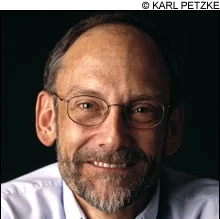Interview: Harold McGee (Boston Phoenix)
Before Alton Brown had even opened a culinary-school brochure, Harold McGee had written On Food and Cooking. This food-science manual (originally published in 1984, revised in 2004) is now an essential kitchen companion. And McGee's column, "The Curious Cook," appears monthly in the New York Times. Now, he's back with Keys to Good Cooking: A Guide to Making the Best of Foods and Recipes(Penguin Press), in which, in easy-to-swallow bites, he offers home cooks the tools with which to navigate a vast and imperfect field of recipes. His advice is mercifully practical, from burner efficiency to managing broken yolks, and he turns the table on the most pervasive kitchen myths. And he delivers it all with the kaleidoscopic wonderment of someone who once referred to browning as "creating the universe in a star." He'll appear on December 6 at Harvard Book Store with chef Jody Adams.
How has thinking about science in the kitchen changed how we eat on an everyday basis?
Many more people nowadays are thinking about the facts, the chemistry, and the physics behind cooking. They have brought into common use techniques that were not so common five or 10 years ago, and that has made a tremendous difference in the overall quality of foods that are served in restaurants.
You've said that this book will help cooks cook better. How can recipe writers improve?
By thinking more about the necessary translation process that goes on in the kitchens of people who cook those recipes, and I think simply being aware of the tremendous variability that's possible there. Think about things like, for example, giving weights rather than volumes for dry ingredients, because volume measurements are so imprecise and often completely misleading.
Much of your work targets misconceptions. What are some of the most pervasive? I'm thinking of the discussion of how it's believed that searing seals in juices, or that wet cooking guarantees moist meat.
Those are the two I keep hearing over and over again — just a basic misunderstanding of how cooking meat and fish, and any protein-containing food, works. It all does come down to temperature, and so moist heat, searing, any other things that you think might make a difference in the moistness, the juiciness of a piece of meat — they don't. It really just does come down to a number.
Where were those tales born?
The searing idea comes from a 19th-century German chemist [Justus Liebig]. He believed mistakenly that the most nutritious part of meat is the juices, and therefore you should try to keep them in the meat. I think his model was something like cautery, where you can seal a wound with very high heat. Because he was a prominent chemist and he published this in a book, recipe writers almost immediately adopted it, even though it was completely contrary to tradition and completely wrong, and anyone who has cooked a steak or chop knows that, just by observing what happens when you're done. It might be the same story as cooking in a moist environment guaranteeing you moist food: it just sounds common-sensical — you can picture it happening. It gives you a reassurance that you're going to end up with something good, and we always want that.
This interview originally appeared in the Boston Phoenix, December 1, 2010. Interview by Lindsay Crudele.


